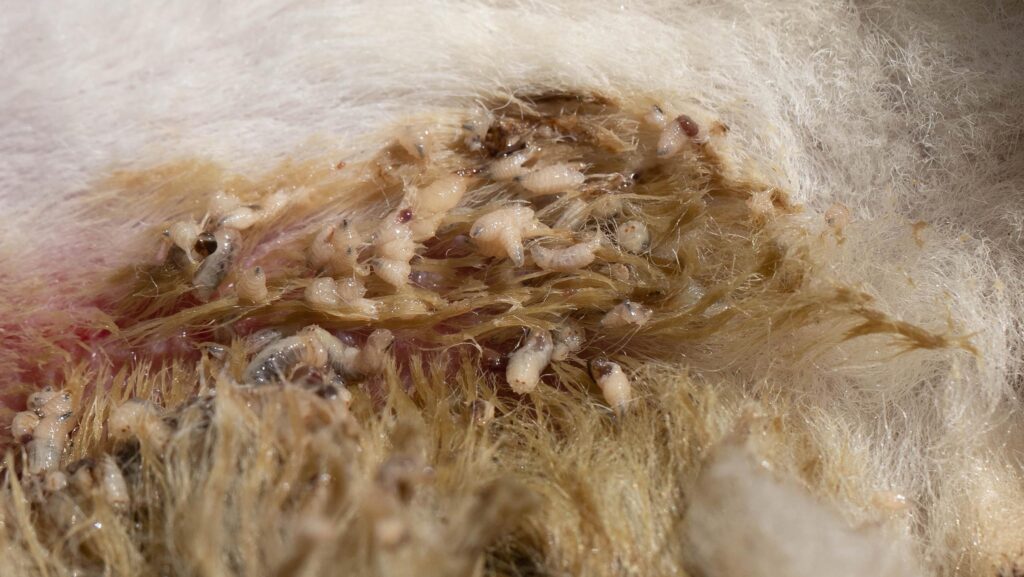Amber blowfly warning as warm weather triggers season
 © Tim Scrivener
© Tim Scrivener Sheep farmers are advised to start checking for signs of blowfly strike and plan treatment for the blowfly season.
An amber warning has been put in place across southern England and parts of Wales.
This is according to Prof Richard Wall of the University of Bristol, who says the recent spell of warm weather is accelerating blowfly development.
The current risk in these areas is now at medium, which means “act now”.
See also: Advice on developing a worm control plan for sheep
“While the first strikes would still not be expected until about mid-April, the forecasts indicate that the start of the blowfly season is approaching in these areas,” says Richard.
“So, this is the time to begin making treatment plans for the start of the season.
Preventative action
The National Animal Disease Information Service (Nadis) advises checking flocks carefully – at least once daily throughout the blowfly season to check for any signs of blowfly strike.
Matt Colston, ruminant technical consultant at Elanco, says it is worth sheep producers considering early preventative action when the Blowfly Watch service issues risk alerts in their area.
“Damage happens fast – it can take as little as 36 hours from an egg being laid on a sheep to maggots eating its flesh – so prevention is better than waiting to see a struck lamb before treating the whole flock,” he says.
Worm management plays a valuable role in preventing blowfly strike because scouring (caused by parasitic worms) can cause dirty back ends and encourage flies.
Matt recommends taking regular faecal egg counts to identify worm burdens early and prompt treatment where needed.
Plan and prepare
Richard advises that a small proportion of the blowfly population overwinter in sheltered spots, such as in or around barns or sheds.
This means some emergence is possible even before the date forecast for the emergence of the general fly population, so close inspection is needed.
Blowfly strike has serious welfare and productivity implications, causing weight loss, decreased milk yield, fleece damage and death, as well as treatment costs.
Signs of strike
Early signs include irritation, nibbling at the tail head, increased swishing of tails, rubbing and further signs of discomfort in lame animals.
Signs of severe strike are a discoloured or damp fleece, affected sheep separating themselves from the flock, sickness and death from septicaemia caused by secondary bacterial infection.
Tips for preventing blowfly strike
- Apply a preventative product before the main risk period for flies
- Discuss choice of product with the farm vet – this will depend on labour resources, age of lambs during the risk period, withdrawal periods and anticipated slaughter dates
- If an insect growth regulator (IRG) is used, this will not kill maggots but will disrupt the maggot lifecycle, preventing development of the mouthparts that cause the sheep harm
- Reduce dirty back ends by, for example, dagging, crutching and timely shearing
- Control worm burdens
- Treat lame sheep promptly – flies are attracted to wounds caused by foot-rot
- Manage the fly population early in the year as this has the greatest impact on the fly challenge during the grazing season
- In high-risk periods, consider grazing more exposed pastures
Source: Nadis
Tips for treating blowfly strike
- Clip the entire affected area
- Apply an effective product to kill the maggots
- Inject non-steroidal pain relief and use spray, or injectable, antibiotics to cover secondary bacterial infection
- Discuss any treatment with the farm vet
Source: Nadis
Download information on blowfly strike preventative and treatment products [PDF].
Blowfly strike alerts
Blowfly Watch is run by Nadis with Elanco.
Predictions for this service are made using Met Office recordings of daily temperature – including soil temperature – and rainfall, fly biology and sheep susceptibility to blowfly strike.
Farmers can sign up for free Blowfly Watch alerts and report cases of blowfly strike.
